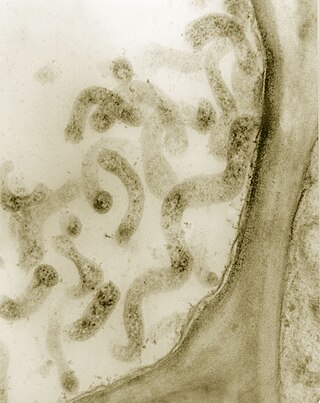
Entomoplasmatales is a small order of mollicute bacteria.
The Veillonellaceae are a family of the Clostridia, formerly known as Acidaminococcaceae. Bacteria in this family are grouped together mainly based on genetic studies, which place them among the Bacillota. Supporting this placement, several species are capable of forming endospores. However, they differ from most other Bacillota in having Gram-negative stains. The cell wall composition is peculiar.
The Jiangellaceae are the only family of the order Jiangellales, which is a part of the phylum Actinomycetota.
The Selenomonadales are an order of bacteria within the class Negativicutes; unlike most other members of Bacillota, they are Gram-negative. The phylogeny of this order was initially determined by 16S rRNA comparisons. More recently, molecular markers in the form of conserved signature indels (CSIs) have been found specific for all Selenomonadales species. On the basis of these markers, the Selenomonadales are inclusive of two distinct families, and are no longer the sole order within the Negativicutes. Several CSIs have also been found specific for both families, Sporomusaceae and Selenomonadceae. Samples of bacterial strains within this order have been isolated from the root canals of healthy human teeth.
Phycisphaerae is a class of aquatic bacteria. They reproduce by budding and are found in samples of algae in marine water. Organisms in this group are spherical and have a holdfast, at the tip of a thin cylindrical extension from the cell body called the stalk, at the nonreproductive end that helps them to attach to each other during budding.

Haloferacaceae is a family of halophilic, chemoorganotrophic or heterotrophic archaea within the order Haloferacales. The type genus of this family is Haloferax. Its biochemical characteristics are the same as the order Haloferacales.
The Silvanigrellaceae are the only family of the order Silvanigrellales, of the class Oligoflexia.
Silvanigrella is a genus of the phylum Bdellovibrionota. The genus currently contains two described species: Silvanigrella aquatica and Silvanigrella paludirubra.
Phycisphaeraceae is a family of bacteria.
The Iamiaceae are a family of bacteria in the phylum Actinomycetota.
Euzebya is a genus of Gram-positive bacteria.
The Atopobiaceae are a family of Actinomycetota.
Isosphaeraceae is a family of bacteria.
Pirellulales is an order of bacteria.
Lacipirellulaceae is a family of bacteria.
The Pirellulaceae are a family of bacteria.
Bacteriovoracales is an order of bacteria.
Tepidanaerobacteraceae is a family of Gram positive bacteria in the class Clostridia.
Holophagae is a class of Acidobacteriota.
The Acanthopleuribacteraceae is a family of Acidobacteriota.

